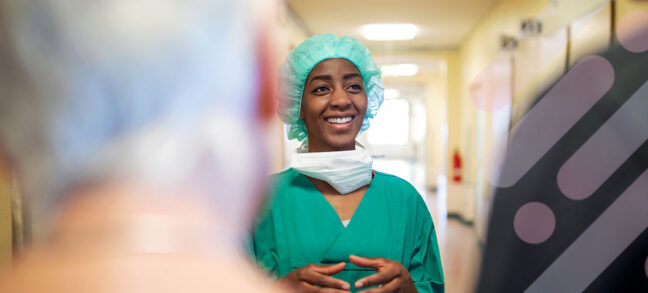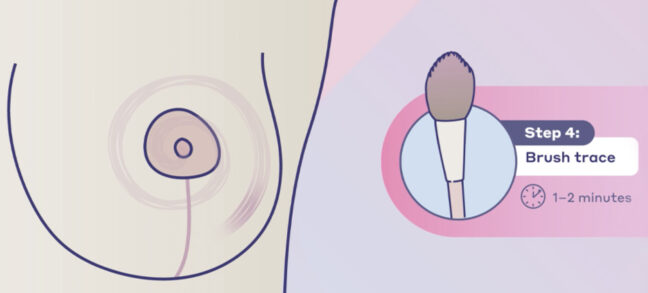When a woman undergoes a mastectomy, she’s faced with many decisions. A major one is whether she wants to have breast reconstruction.
Research shows the number of women choosing reconstruction has risen significantly over the past several decades. In 1998, 46% of women with breast cancer received reconstruction, according to a study in the Journal of Clinical Oncology that analyzed medical claims from over 20,000 women with employer-sponsored health insurance.1 By 2007, that number had risen to 63%. According to the study, women who have had a bilateral (double) mastectomy were the most likely to seek reconstruction, with three-quarters choosing to restore their breasts.1
If you’re planning on having a mastectomy or have already had a mastectomy and are considering breast reconstruction, educating yourself about breast reconstruction options can help you make informed and confident decisions about which route you want to take.
Types of breast reconstruction
There are two main types of breast reconstruction surgeries.
Breast implants, which use silicone or saline-filled sacs to recreate the breast size and shape. This type of reconstruction typically includes the use of expanders to stretch existing skin to make space for the implants.
Autologous reconstruction or free flap reconstruction, uses your own body tissues to reconstruct the shape of a breast. Tissue can be taken from multiple areas of the body, including the abdomen, back or buttocks. One of the most common forms of autologous flap breast reconstruction is the DIEP (deep inferior epigastric perforator) flap, which removes excess tissue from the abdomen, resulting in a “tummy tuck” effect.
Resensation® is an advanced surgical technique in which select plastic surgeons use allograft nerve tissue to reconnect nerves severed during mastectomy to those in the new breast, potentially restoring sensation.

The decision to have breast reconstruction
Deciding whether to have breast reconstruction is a very personal choice. Some women who have been through breast cancer want no part of the additional surgery or added recovery time associated with reconstruction.
But other women have a strong desire to look and feel more like they did before the mastectomy. They may feel that restoring their breast shape will help them put the stress of cancer and the trauma of mastectomy behind them, as well as make them feel more content with their current body.
Numerous studies have found reconstruction potentially offers psychosocial benefits for women, including reduced psychological distress, and improved body image, self-esteem and feelings of well-being.2
“Having a mastectomy is traumatic for many women,” said Dr. Ivica Ducic, a plastic surgeon, nerve surgery expert and medical director for Axogen. “Having the physical reminder of cancer can be a post-traumatic stress stimulus. The more you can help women look and feel the way they did before the mastectomy, the more you can potentially improve their psychological health and all-around health.”
Breast reconstruction factors to consider
There are many factors women should consider when deciding whether to have reconstruction. Here are a few to think about along with questions to ask your breast surgeon and plastic surgeon.
How important are your breasts to your self-image?
This answer is unique to each woman. Some women want a permanent breast shape that moves with them and looks natural when wearing a bathing suit and form-fitting outfits. Other women are comfortable with a wearable artificial breast shape that they can take in and out of their bra when they wish. Others are comfortable with not using a prosthetic at all, sometimes referred to as “going flat.”
How many surgeries are needed, and how long is the recovery time?
Breast reconstruction procedures vary in complexity. The potential for complications and recovery time also differs among types of procedures. For example, women with large breasts may choose to have breast reduction on their remaining breast so they look as symmetrical as possible after reconstruction.
Women will need to discuss all their options with the breast surgeon and plastic surgeon and determine which route will best meet their personal goals and desired outcomes.
Immediate or delayed reconstruction?
Women may also be able to choose whether to have breast reconstruction at the same time as the mastectomy (immediate reconstruction) or to wait until after cancer surgery and cancer treatments are finished. Delayed reconstruction may happen months or even years after the mastectomy.
Women should discuss their preferences with their breast surgeon and plastic surgeon. Their surgical team can then make recommendations about whether it’s advisable to seek immediate reconstruction or to wait. Surgeons may take into account additional cancer treatments needed and other medical conditions a woman may have in making their recommendations. For example, smoking raises the risk of post-surgical complications, so it may be advisable to quit first and have surgery later on.3
Do you prefer autologous reconstruction or implant reconstruction?
Plastic surgeons in the U.S. perform more implant reconstructions than autologous reconstructions.4 As a result, women may have an easier time finding a plastic surgeon who does implant reconstruction than those who specialize in autologous reconstruction. Of the 106,295 breast reconstruction procedures done in the United States in 2017, 82,579 women chose silicone implants and 4,400 choose saline. Just over 19,300 women choose autologous reconstruction.4
Plastic surgeons may specialize in one or the other, so if you’re considering an autologous reconstruction, it’s important to find a plastic surgeon with expertise in this area. Some studies indicate that women who choose autologous reconstruction are more satisfied with their breasts and with their overall outcomes than women who choose implants.5
Do you want the option of a potential return of breast sensation?
During a mastectomy, the nerves that allow the brain to detect feeling – such as touch and temperature – in the breasts are cut. Women who undergo a mastectomy typically have little to no feeling in the area where tissue was removed. This numbness can remain even after traditional breast reconstruction using implants or autologous tissue.
Resensation is a new surgical technique in which plastic surgeons with expertise in microsurgery reconnect nerves in the chest to those in the newly constructed breast using allograft nerve tissue, potentially leading to a return of feeling. Resensation is a form of breast neurotization, or breast nerve repair.
Resensation can be performed in women who have immediate or delayed reconstruction.
Questions for your surgical team before breast reconstruction
The decision to seek breast reconstruction can be complex. A woman’s overall health, lifestyle, financial resources, and her personal preferences and goals all factor into the decision about whether to pursue breast reconstruction, whether to seek immediate or delayed reconstruction, and whether to choose implant or autologous reconstruction. All of this should be discussed with your surgical team, including your breast surgeon and your plastic surgeon – if possible, before the mastectomy.
However, women should be aware that not all plastic surgeons or hospitals offer autologous breast reconstruction. If you’re considering autologous reconstruction, you may need to research surgeons and hospitals that specialize in the procedure.
In addition, there are multiple types of autologous reconstruction, such as DIEP flaps, TRAM flaps and latissimus dorsi flaps. When it comes to autologous reconstruction, Resensation is recommended for DIEP flap procedures but can possibly be used with other flap procedures as well.
When making recommendations about the type of reconstruction you may be a candidate for, surgeons will take into account the characteristics of your cancer, your overall health, your body type (such as how much tissue is available to be moved from one location to the other) and other factors. Make sure your surgeon also considers your personal preferences and desired outcomes regarding restoring sensation.
If you’re interested in pursuing Resensation, use our surgeon locator to find the select hospitals and plastic surgeons currently offering this advanced technique.
_________________________
1http://ascopubs.org/doi/abs/10.1200/jco.2013.52.2284
2https://www.ncbi.nlm.nih.gov/pmc/articles/PMC3929332/
3https://www.ncbi.nlm.nih.gov/pubmed/23357982
4https://www.plasticsurgery.org/documents/News/Statistics/2017/reconstructive-breast-procedures-age-2017.pdf
5https://www.ncbi.nlm.nih.gov/pmc/articles/PMC5293311/
Resensation Articles

How does mastectomy impact the nerves in the breast?
One sometimes overlooked aspect of mastectomy is its impact on nerves. Read what happens to nerves during mastectomy and explore…
Read More
What happens during implant breast reconstruction with Resensation®?
By repairing sensory nerves, Resensation® enables you to potentially regain sensation to your chest. Read how this procedure works during…
Read More
how resensation® helped Leanna feel secure in her family’s future
With Resensation®, Leanna can be there to watch her kids grow up—without losing the feeling of being whole.
Read More
post-surgery sensory retraining: instructions and video guide
Sensory retraining is a series of exercises designed to help you reconnect with your body after breast reconstruction with Resensation®.
Read More